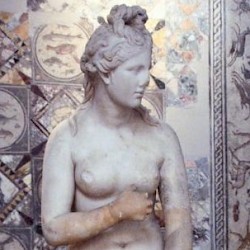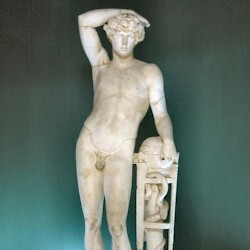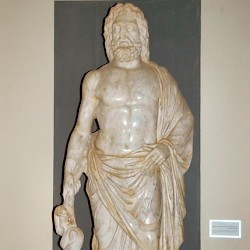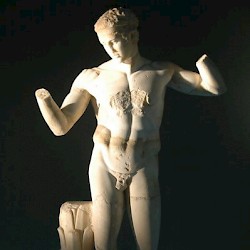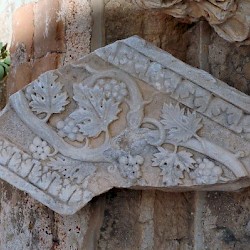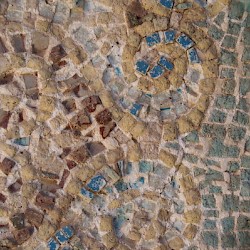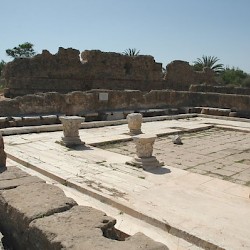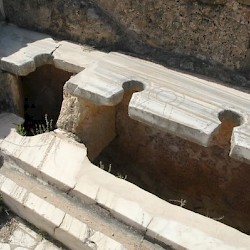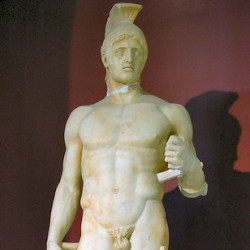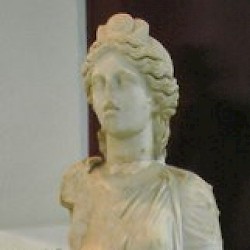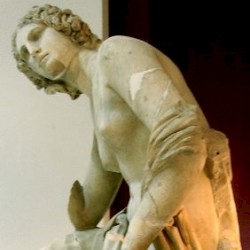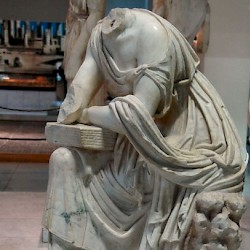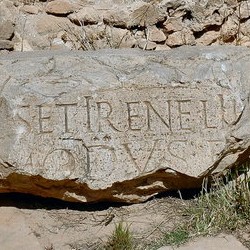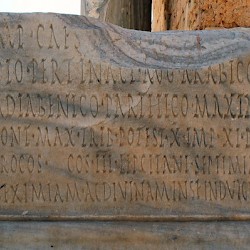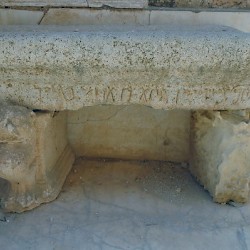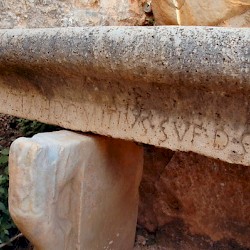Lepcis Magna, Hadrianic Baths
Q68122045Lepcis Magna: Phoenician colony, later part of the Carthaginian empire, the kingdom of Massinissa, and the Roman empire. Its most famous son was the emperor Septimius Severus (r.193-211).
Hadrianic Baths
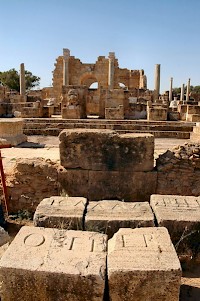
The first photo shows the inscription that is recorded as IRT 361. It commemorates how a governor named Publius Valerius Priscus, acting through his deputy, a man called Popilius Celer, opened a public bathhouse in Lepcis Magna, when the emperor Hadrian held the tribunician powers for the twenty-first time (our year 137 CE). Archaeologists call this building the "Hadrianic Baths" and it is one of the most splendid monuments in Lepcis. Behind the inscription on the photo, one can see a swimming pool (natatio) with a length of almost thirty meters, and behind that are the remains of the tepid and warm baths.
The Hadrianic Baths appeal more to modern tastes than the monuments of the Severan age (e.g., the basilica) which most people think are too pompous. Still, the Hadrianic Baths were, in their own days, just as magnificent. A very large building indeed: in Africa, only the bathhouse in Carthage was bigger.
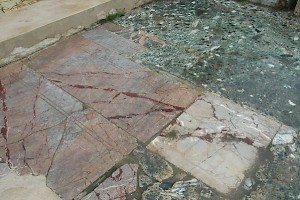
To the east and west of the swimming pool were two dressing rooms (apodyteria). After that, you would pass through a central hall along two cold water baths (frigidaria), along two tepid baths (tepidaria), to two warm water baths (caldaria). In other words, the entire complex is symmetrical, and it is possible that men and women could bathe at the same time, separated from each other. Only the hot bath may have been accessible to only one group at the same time. The second photo in the gallery below shows the northern wall of the central hall between eastern and western cold water baths. The gate leads to the tepid baths.
The columns surrounding the pools in the eastern and western frigidaria were made of granite, which had been imported from Egypt. The hall between the two cold water baths, which measured about 20 x 18 meters, was covered by cross-vaults in three sections; it was supported by eight heavy Corinthian columns made of cipollino, a type of green-white marble that was imported from Karystos in Greece.
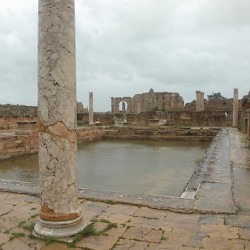 Lepcis Magna, Hadrianic Baths, Natatio |
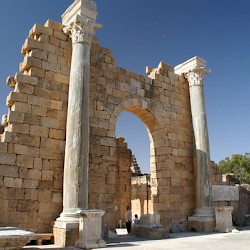 Lepcis Magna, Hadrianic baths, frigidarium |
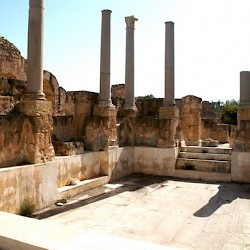 Lepcis Magna, Hadrianic baths, Western frigidarium |
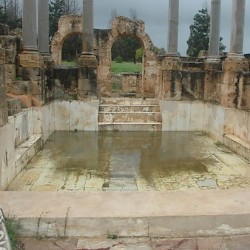 Lepcis Magna, Hadrianic baths, Eastern frigidarium |
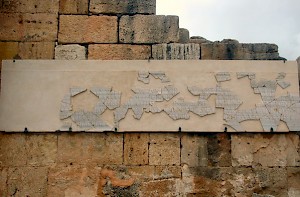
Although the Lepcitanians lived in a cosmopolitan city, the use of stones from other provinces of the empire was a luxury they had not seen before. It is interesting to know that building the bathhouse, with all its splendor, was a long-term project, which had been prepared by constructing an aqueduct many years before. Funds must have been created well in advance of the building of the baths.
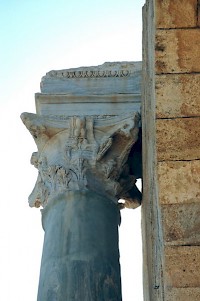
The damaged inscription known as IRT 396, which was found in the frigidarium, records restoration works by a mayor called Rusonianus. According to the text, which contains several spelling mistakes, the project is dedicated to the emperor Septimius Severus, his wife Julia Domna, and his son Caracalla. It also mentions that a new statue of Asclepius was erected, perhaps the statue shown below.
The cold water bath (and, in fact, the entire bathhouse with the adjacent Palaestra) was decorated with several statues, although not of the same quality. The gallery of photos below offers an impression.
To the left is a splendid statue of Venus. It is a copy from the second century BCE of a famous original by Praxiteles (fourth century BCE), that was already celebrated in Antiquity.note The statue is also known as the Aphrodite of Cnidus (after the location of the original) or Capitoline Venus (because the most famous copy is in Rome's Musei Capitolini).
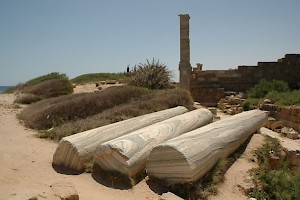
The Lepcitanian copy of the Capitoline Venus, excavated in the 1920s, was taken to Europe by Mussolini, who gave it to the Nazi leader Hermann Göring. The statue graced the bedroom of his country estate near Berlin. It was finally returned to Libya in 1999.
Mussolini was not the first to take away objects from Lepcis Magna. For example, between 1686 and 1708, the French consul in Tripoli, Claude Lemaire, took away several cipollino columns. Much of it was reused when the palace of Versailles was built, a part was donated to Windsor Palace near London, but these columns were left behind on the beach.
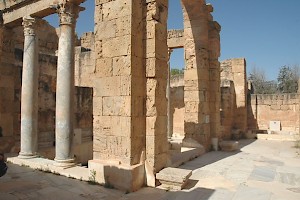
Back to the Hadrianic Baths themselves. After the apodyteria, the central hall and the cold frigidaria, an ancient visitor would pass along tepidaria. East and west of the tepid bath were the sweat rooms, laconica. As the second photo below shows, the floor was raised, which permitted hot air to the circulate underneath. The system was called hypocaustum. The walls were made of hollow bricks (tubuli), which enabled hot air to heat up the wall, similar to the pipes of a modern central heating system.
Having passed the tepid baths and the sweat rooms, a visitor would have reached the warm sudatorium, the southernmost room of the bathhouse. This warm water bath was also known as caldarium. (The photo below is a bit out of focus because it was impossible to get rid of the raindrops on the lens.) The wall, which was covered with Numidian yellow-red marble, contained windows to let in the sunlight, which must have been closed by small plates of selenite; otherwise, too much heat would be lost.
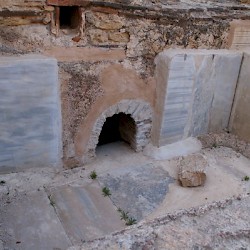 Lepcis Magna, Hadrianic baths, Laconica, bathttub |
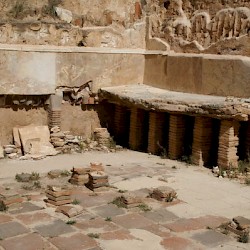 Lepcis Magna, Hadrianic baths, Laconica with hypocaust |
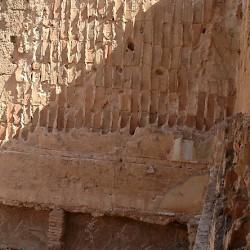 Lepcis Magna, Hadrianic baths, Laconica, tubuli |
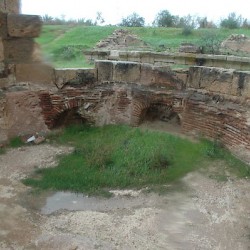 Lepcis Magna, Hadrianic baths, Sudatorium |
The furnaces (praefurnia) were just south of the main complex, and although this position may have facilitated heating the laconica, the owner of the bathhouse must gave found it hard to obtain sufficient wood in Libya, which has not many forests.
There were several inscriptions in the baths. Below, you can see several of them. The one to the left is incomprehensible. The second one, known as IRT 393, is a pretty stereotypical dedication by the Lepcitanians to the emperor Septimius Severus, whos name is missing from the damaged first line. The two photos to the right show IRT 599, in Latin and Punic. It says that the suffete (mayor) Iuttaph Domitius ordered something to be made and that the overseers of the market gave it as a present to the city. It is not known what was made and presented, but it is certain that the text refers to something that was built in the second half of the first century, when it was still common to give the mayor a Punic title, and when hybrid names like Iuttaph Domitius were still en vogue. The inscription was later reused in a bank, probably after the monument on which it could originally be read, was demolished.
